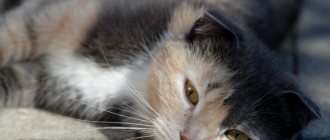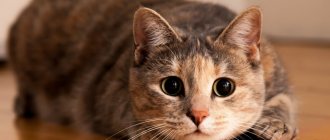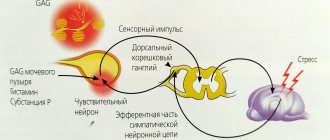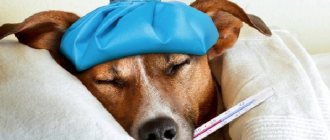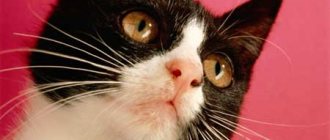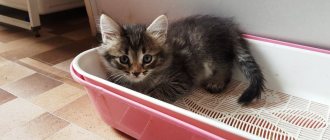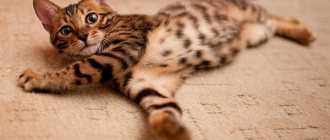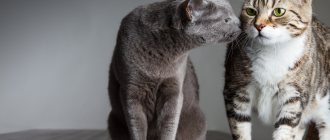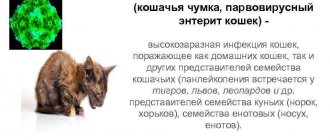Causes
The bile pigment bilirubin is a waste product of the breakdown of hemoglobin. Its high concentration in the blood gives the corresponding color to the mucous membranes and open depigmented areas of the skin. According to the causes of occurrence, jaundice is divided into the following types:
- hemolytic (suprahepatic);
- hepatic (parenchymal);
- mechanical (subhepatic).
Jaundice of the mucous membranes of the mouth
Hemolytic jaundice
The reason for the increase in the concentration of bile pigment is hemolysis, that is, increased breakdown of red blood cells. Bilirubin is toxic, the body tries to get rid of it in all ways, through the mucous membranes and skin. This situation is typical for infectious diseases or poisoning. The following pathologies are contagious causes of the development of suprahepatic jaundice:
- viral infections;
- dirofilariasis – helminthic infestation;
- hemobartonellosis is a disease caused by rickettsiae that parasitize red blood cells;
- leptospirosis.
Hemolysis can be caused by insect bites or by eating rodents poisoned with anticoagulants.
Hepatic jaundice
Organ damage occurs under the influence of the following harmful factors:
- infectious diseases;
- side effects of medications;
- hepatitis;
- liver failure;
- cirrhosis;
- lipidosis;
- malignant neoplasms.
Obstructive jaundice
Caused primarily by blockage of the bile ducts for the following reasons:
- inflammation of the bladder;
- compression of the ducts of the hypertrophied pancreas;
- cholelithiasis.
How it manifests itself
The presence of the disease is indicated by yellowness of the skin of the inner surface of the ears, mucous membranes of the mouth, tongue, and eyeballs. If such symptoms appear, you should immediately contact a veterinarian .
The main provoking factor in the development of pathology in cats is an increase in bilirubin levels.
This substance is considered one of the most important for the body: thanks to the pigment, which is a product of the breakdown of hemoglobin, tissues and anatomical structures receive the necessary amount of oxygen.
Disposal occurs in the liver. With dysfunction, the organ cannot fully cope with the task, as a result of which, under the influence of bilirubin, the skin becomes colored in a characteristic shade.
This condition is considered pathological and requires immediate professional help.
Diagnostics
Blood tests for different types of jaundice show different results. The detection of young forms of red blood cells in the blood, an increase or decrease in the concentration of bilirubin is of diagnostic importance. Testing the activity of alkaline phosphatase and liver transaminases is informative. The content of pigments - stercobilin, urobilinogen, bilirubin - is determined in urine and feces. If necessary, the veterinarian prescribes ultrasound and radiographic examinations.
With hepatitis, the cat is exhausted
Jaundice in cats: signs and care for a sick animal
Jaundice is a change in the color of the gums and tissues.
This happens due to the high concentration of bilirubin, the pigment of bile. It is formed in the body during the normal processing of hemoglobin from red blood cells (RBCs). It, as we remember, serves to transport oxygen to the cells and tissues of the body. If hemoglobin is utilized at an accelerated rate, there is a rapid accumulation of bilirubin in the body. The cause of its accumulation may also be a disease that somehow prevents the release of the substance into the external environment. Today we will talk about why jaundice is dangerous in cats, and what owners should do if it is detected.
First, you should know about the clinical manifestations of the pathology.
Symptoms of jaundice in a cat and how to treat it
Jaundice is a dangerous condition of the body, characterized primarily by yellowing of the mucous membranes of the mouth, lower eyelid, sclera, and inner surface of the ear.
Lemon-yellow skin in a pet should greatly alert the responsible owner, as this symptom indicates the presence of serious health problems.
What is this condition and how to deal with it?
Jaundice in cats is not an independent disease; it is a clear symptom of many pathological conditions.
Jaundice is caused by high levels of bilirubin. This useful substance, the so-called bile pigment, is part of hemoglobin, which is contained in erythrocytes - red blood cells that supply tissues and organs with oxygen.
They are utilized in the liver, which produces the components it needs from their breakdown products. If the liver cannot cope with this task, bilirubin turns the cat's skin a characteristic color.
Naturally, this is an abnormal condition of the body, requiring immediate contact with a veterinary service.
Jaundice in a cat is accompanied by the following symptoms::
- the color of urine and feces changes (urine becomes orange, feces become whitish)
- fever
- severe chills
- weakness
- poor appetite
- bloating
- diarrhea
- vomit
- extreme thirst
- excessive urination
- changes in behavior (aggressiveness or apathy)
Treatment for feline jaundice
Its treatment depends primarily on the underlying cause and differs in each individual case. When the primary disease is advanced and the cat’s condition is critical, he will most likely have to be hospitalized.
If the situation is not critical, and the owner of the animal seeks medical help at the first symptoms of the pathology, then a diet is prescribed that facilitates the functioning of the liver. Vitamins and iron-containing preparations are used.
When jaundice is caused by a cyst compressing the bile ducts, it will most likely have to be removed surgically.
European veterinary clinics practice blood transfusions for sick animals. But in our medical institutions such manipulation is rarely carried out. The reason is that in our country there are no centralized blood banks for pets.
The prognosis of jaundice in cats depends on the underlying cause, severity and treatment prescribed by the doctor. With strict adherence to the diet and doctor’s recommendations, you can quickly restore your cat’s compromised health.
But you cannot change the prescribed treatment regimens or drug dosages. This is especially true for analgesics, because they are toxic even to the liver of healthy animals.
If treatment was started at the wrong time, it may become chronic and never recover completely.
The diet of a cat with jaundice is characterized by a minimum of fat and a balance of essential minerals and vitamins. If the animal owner is inexperienced, then it is better to buy special food for cats with liver failure.
It is worth knowing that cat jaundice does not pose a danger to the health of the owner - it is not contagious.
It’s good when he’s healthy, but if you notice yellowing of the gums or the inside of the ears, immediately run to the vet. Most likely, these are the first symptoms of increased bilirubin, which means jaundice, which is dangerous for the animal.
Why did the cat turn yellow?
Taking into account a number of reasons
jaundice that causes this pathological manifestation is divided into only three types:
- Hemolytic or suprahepatic jaundice occurs due to increased breakdown of red blood cells. This can happen for several reasons:
- feline dirofilariasis (parasitic helminthic disease), leptospirosis,
- blood parasites (feline hemobartonellosis),
- intoxication with certain drugs and poisons (for example, as part of rodent poison), snake bites, spider bites;
- severe viral infections (leukemia, immunodeficiency virus).
2. Hepatic jaundice is a consequence of liver disease. It could be:
- poisoning with hepatoxins (mercury salts, lead, drugs - paracetamol, diazolin, insectoacaricides);
- infections of both viral and bacterial origin;
- hepatitis (liver inflammation);
- hepatosis (liver failure, metabolic disorders in the liver);
- parasitic liver diseases are leptospirosis, opisthorchiasis and echinococcosis, as well as toxoplasmosis;
- cirrhosis of the liver (degeneration of its tissue into connective tissue with disruption of all functions);
- oncological neoplasms of the liver.
Liver diseases will also be accompanied by vomiting, loss of appetite, and changes in the color of urine and feces.
3. Mechanical (subhepatic) jaundice occurs when bile stagnates in the bile ducts. This is a consequence of diseases such as:
- chronic cholecystitis - inflammation of the gallbladder,
- pancreatitis - inflammation of the pancreas,
- cholelithiasis (formation of stones in the gall bladder),
- pathologies of the sphincter of Oddi (spasm, polyps, etc.).
Predisposing factors to the disease
Jaundice is caused by high levels of bilirubin in the blood. This bile pigment is formed in the cat's body as a result of the processing of hemoglobin from red blood cells.
Hemoglobin is the most important component of blood, which saturates all organs and cells with oxygen.
If hemoglobin is processed too quickly, the produced bilirubin does not have time to be utilized through the liver and gradually accumulates in the body, causing intoxication.
Jaundice often occurs due to liver disease.
Often, jaundice can occur due to concomitant liver diseases (cancer, cirrhosis, hepatitis), tumors compressing the bile ducts, or due to taking certain medications.
It can be triggered by rupture of the gallbladder, blood diseases, bacterial infections, obesity, the presence of worms in the body, and poor quality nutrition.
Jaundice can be caused by various bacterial and viral infections, blood transfusions, hepatic lipidosis, and impaired bilirubin production.
Diagnostic methods
To make the correct diagnosis
For your “yellowed” pet, the veterinarian will definitely interview you in detail about the cat’s condition, nutrition, and behavior.
Then he will prescribe laboratory tests such as blood biochemistry, blood sugar, coagulogram, general blood test, tests for viral infections, toxoplasmosis, parasitic infestations, and urinalysis. An ultrasound and x-ray may be necessary. Sometimes a liver biopsy is required.
Thanks to these tests, the doctor will reveal where the “culprit” of jaundice is hiding and determine the disease. Having made a prompt diagnosis, a veterinarian will most likely be able to cure jaundice in a cat.
How to make a diagnosis
Treatment of the disease directly depends on the cause of jaundice. During the period of treatment, the cat should be under the constant supervision of a veterinarian, preferably in a hospital. Hemolytic jaundice is often an indication for blood transfusion. After diagnosis, drug treatment is prescribed.
The following drugs can be used:
In some cases, the drug Globfel is used for treatment.
- Gemavit;
- Ceftriaxone;
- Ranitidine;
- Immunofan.
Sometimes the antiviral drug Globfel is prescribed, which is administered intramuscularly for at least three days.
To ease your pet's suffering, your veterinarian may recommend the use of painkillers and antiemetic medications. But only in the absence of liver failure.
Under no circumstances should you give a sick animal erythromycin, tetracycline or paracetamol. These drugs destroy the liver.
Many owners have a question: how long does jaundice last in a cat? If treatment is prescribed correctly and started on time, the cat may feel relief within 1-2 weeks. It is difficult to predict when the disease will completely recede.
This depends not only on the cause of the jaundice, but also on the general state of the cat’s immunity, its age and other factors. It is important to remember that all drug treatment should only be prescribed by a qualified specialist.
You should not self-medicate, as it can be fatal.
Jaundice in cats, necessary therapy
- Therefore, often, while awaiting the results of laboratory tests, the veterinarian will prescribe supportive measures for the cat:
- droppers to combat dehydration, correct the level of electrolytes in the blood if the animal suffers from anorexia, vomiting and diarrhea;
- drugs that lower blood sugar levels (as indicated);
- the use of drugs for anemia, hematopoietic stimulants, donor blood transfusions for severe anemia;
- course of antibiotics, antiemetic drugs.
Once the test results are in and the underlying cause of the jaundice is found, your veterinarian will decide on more targeted treatment. This can be surgical intervention (for example, if stones are found in the gall bladder or it is necessary to remove a tumor), and antiparasitic therapy, and the introduction of antidotes for poisoning with certain toxic substances. As you can see, there are many causes of jaundice in cats, so treatment protocols will vary greatly, as will the prognosis for recovery. Therapy for jaundice will be aimed not only at eliminating its root cause (for example, infection or tumor), but also at stopping the processes that it caused. This may be pain syndrome (with obstructive jaundice), oxygen deficiency, or intoxication of the body. For these purposes, analgesics, oxygen therapy, droppers with hepatoprotective drugs, etc. will be used. Another area of treatment is the fight against symptoms such as diarrhea, vomiting, anemia, dehydration
. This will also require the introduction of intravenous drips, vitamin complexes, electrolytes, drugs against vomiting and increased stomach acidity.
Source: https://aquatech-spb.ru/koshki-bolezni/zheltuha-u-koshek.html
Treatment
Treatment strategy:
- eliminating the cause of the disease;
- symptomatic therapy;
- caring for chronically ill animals.
Eliminating the cause of the disease
Depending on the pathogen, antibiotic therapy is prescribed. The sensitivity of mycoplasmas and leptospira to antibiotics is not the same. Rickettsia are susceptible to chloramphenicol and tetracycline, bacteria at the initial stage are susceptible to penicillin antimicrobial agents. Treatment is long-term and requires changing antibiotics. In parallel, maintenance therapy is carried out, as well as immunocorrection with Gamavit, Immunofan or Roncoleukin.
Ronkoleikin
If the main cause is dirofilariasis, pyrantel or other anthelmintics are used. Viral diseases are treated according to developed programs.
In all cases, it is necessary to eliminate the symptoms of anemia. This is achieved by switching to premium food. Sea fish is removed from the diet, some types of which contain substances that block the absorption of iron. They use drugs containing cyanocobalamin and folic acid, which are necessary for the synthesis of hemoglobin. Some diseases require surgery.
Symptomatic therapy
Used when acute phenomena are stopped. Hepatoprotectors are used - Sirepar or Essentiale Forte, but the main method of treatment is diet therapy. Cats need gentle nutrition, which cannot be reproduced at home from natural products. Therefore, premium medicinal food is used for cats with liver disease.
Therapeutic food for cats with liver disease
For liver diseases, many drugs that place additional stress on the organ are contraindicated. If leptospirosis is diagnosed, then you should choose medicated food for cats with kidney disease.
Caring for chronically ill animals
The owner of a cat who has had jaundice must come to terms with the fact that the pet will need lifelong care. The disease disables a significant part of the liver. Treats should be avoided in favor of diet food. You cannot give painkillers familiar to humans on your own; they can kill your pet. An alarming symptom is lightening of feces and darkening of urine.
Is the condition dangerous for humans?
Jaundice is a symptom indicating the development of a pathological condition in an animal, and the parasites that live in a pet’s liver are harmless to humans.
The only danger to humans is leptospirosis, which is accompanied by yellowing of the skin and mucous membranes.
Infection is possible through contact with feces or urine of a sick cat, which occurs when washing the tray or during cleaning. In such situations, you must be extremely careful and follow all safety measures.
Prevention
Jaundice is a symptom of a large number of diseases. It is not those cats that are infected with something that get sick, but animals with reduced immune defenses. Animals that eat nutritious food and live in a comfortable environment are less likely to get sick. To maintain immune defenses, cats are regularly dewormed, skin parasite free, and vaccinated.
Jaundice is a symptom of infectious and non-communicable diseases. Concomitant factors for the occurrence of the disease are unbalanced feeding and unsatisfactory maintenance. Leptospirosis is considered a common disease for humans and cats.
We invite you to join our Zen channel and group on VKontakte or Odnoklassniki, where new articles for pet owners are published.
Similar articles:
- If your cat has food allergies
- Ringworm Caution: What Pet Owners Need to Know
- Why are cats overweight?
Symptoms
Since the effectiveness of treatment depends on the timely detection of the disease, you should be wary if the cat has become lethargic and has lost its appetite. At the initial stage, the disease can be detected in a pet by a subtle yellowing of the gums and all mucous membranes. However, this symptom cannot be noticed in pets that are black or other dark colors.
Also symptoms of jaundice in a cat are:
- Frequent vomiting.
- Periodic febrile conditions.
- Diarrhea.
- Weight loss.
- The urine color changes to bright orange, and the stool takes on the consistency and color of light plasticine.
- Increased frequency of urination, increase in the total daily volume of urine.
- Intense thirst.
Causes of cough in cats
Papillomas
White vomit in a cat
In advanced stages, the animal may experience internal bleeding caused by liver destruction.
In the hemolytic form, which is characterized by an abrupt onset, the color of the stool becomes orange. There is an increase in lymph nodes, the size of the spleen and liver.
With hepatic jaundice, disturbances in the cat’s mental behavior are observed: it may behave inappropriately, aggressively, or, on the contrary, apathetically. With this form of pathology, the cat constantly drinks a lot of water, and there is a marked increase in saliva production.
With the mechanical form, the pet is bothered by painful sensations in the abdomen - this can be noticed when trying to pick up the cat. The animal loses a lot of weight and its belly gets bigger.
Diagnosis
The veterinarian should interview you in detail and then take any necessary tests from your animal. Routine laboratory tests include the following: complete blood count, including biochemistry, urine test. In some cases, it is necessary to resort to liver biopsy. These tests will provide very valuable information for making an initial diagnosis. Checking blood biochemistry will show the state of the hematopoietic system and other parameters, allow you to diagnose severe anemia, blood parasitic infections and promptly detect clotting disorders. In addition, it is incredibly valuable in that it allows us to identify pathologies associated with the synthesis of liver enzymes.
Of course, blood testing is not the only valuable method. X-ray studies will help determine the structure and size of the liver or spleen. The veterinarian will see tumors, an enlarged spleen, and in some cases, the presence of foreign bodies. Ultrasound examination is even more important, as it allows us to evaluate the structure of the liver in detail: this is how parenchymal jaundice in cats differs from bile duct obstruction. The same method makes it possible to differentiate a tumor from a cyst of parasitic etiology.
Main predisposing factors
- Diseases, toxins, drugs, the side effect of which may be the destruction of red blood cells.
- Transfusion of blood of an incompatible group (in our conditions this reason is rare).
- Infections of viral and bacterial etiology.
- In extremely rare cases - pathologies of the hematopoietic system, in which the number of red blood cells and the volume of processed hemoglobin sharply increases.
- Inflammation of the liver (), ruptures of the gallbladder. In the latter case, it usually ends in death.
- Tumors compressing the bile ducts (obstructive jaundice in cats).
- Fatty liver ().
- Extensive damage to liver tissue (eg, due to toxins).
- Violations of the secretion and excretion of bilirubin, as well as other reasons listed above.
Causes and symptoms of jaundice in cats. Treatment methods depending on the cause
Jaundice in pets develops due to excessive accumulation of bilirubin in the blood. This substance is a pigment present in hemoglobin, which, in turn, is found in red blood cells.
In a healthy body, after the destruction of red blood cells in the liver, the resulting breakdown products are converted into bile. In case of mass death of red blood cells or disruption of the process of bile excretion, symptoms of jaundice develop.
Depending on the mechanism of development, jaundice in cats can be:
- Adrenal (or hemolytic).
- Hepatic (parenchymal).
- Subhepatic (mechanical).
The causes of adrenal jaundice may include:
- Parasites.
- Exposure to the body of hemolytic poisons (zinc, mercury or lead salts, poisons that enter the body from the bite of spiders or snakes, poisoning by plant toxins, for example, white acacia, castor beans).
- Violation of the structure of erythrocyte membranes.
- Presence of chronic infections.
- Transfusion of inappropriate donor blood to an animal.
Hepatic jaundice is formed due to:
- Development of infectious or non-infectious hepatitis.
- The occurrence of hepatosis, characterized by liver failure, which develops as a result of metabolic disorders.
- Damage to the animal's body by parasites - echinococci, opisthorchiasis, leptospira.
- Oncological lesions of the liver.
- The development of cirrhosis, in which liver cells are replaced by fibrous tissue, which leads to serious disruption of the organ.
- Poisoning with hepatotoxins (poisons or chemicals that have the ability to have a negative effect on the liver).
The causes of obstructive jaundice, characterized by impaired excretion of bile or its stagnation, can be:
- Pancreatitis.
- Presence of stones in the cat's gall bladder.
- Chronic cholecystitis.
- Tumors of the bile ducts, gallbladder or surrounding tissues.
- Polyps in the sphincter area.
Treatment depending on the cause
The choice of treatment for jaundice in a cat depends on the cause of the disease. Therefore, it is important to conduct a thorough and detailed examination, which should include:
- Blood test - carried out to identify altered red blood cells, anemia, study liver enzymes, and assess bilirubin levels. Blood smears are also taken from the cat, the examination of which helps to identify parasites, leukemia, and leptospirosis.
- Urinalysis - allows you to detect bilirubin and urobilinogen.
- Ultrasound of the liver and radiography help determine how much the liver and spleen have increased in size, whether there are tumors and metastases.
After conducting research and establishing the exact cause of the disease, the veterinarian selects the optimal treatment regimen.
Poisoning, poisonous bites
If a cat is bitten by poisonous snakes or spiders, it is necessary to provide assistance no later than 6 hours after the incident. As treatment, the veterinarian uses steroid drugs that neutralize the effect of the poison, as well as drugs whose action is aimed at eliminating swelling and painful shock. Such medications have a positive effect only within 24 hours after receiving the bite.
https://www.youtube.com/watch?v=l18huBCRamM
In cases of severe poisoning with zinc, lead, mercury, and snake or spider venoms, the animal may need to stimulate its respiratory function. For this purpose, devices are used that provide the body with oxygen.
To remove the source of toxins, it is necessary to induce vomiting in the cat using special emetics - table salt solution, hydrogen peroxide solution.
Infectious diseases
How to treat jaundice in a cat caused by a severe infection should only be decided by an experienced specialist. Antibiotics are used to treat infectious diseases, and the choice of drug depends on the type of disease.
In no case should cats be given any medications, especially antibacterial ones, without a veterinarian's prescription. Almost all drugs are processed in the liver, and choosing the wrong drug or dosage can cause liver or kidney failure, coma, and even death of your furry pet.
Under no circumstances should you give:
- Antibiotics belonging to the tetracycline group - such medications help reduce the production of proteins in the liver, which can worsen the cat’s condition.
- Painkillers and analgesics in the presence of liver failure.
- Erythromycin, paracetamol and other hepatotoxic drugs.
Along with antibiotics, the veterinarian can prescribe vitamin preparations and agents that increase the body's resistance to disease. When the temperature rises, antipyretic medications are used. Along with antibiotics, medications are prescribed to prevent allergies to the antibacterial drug.
Hepatosis
Common causes of hepatosis are helminths, insufficient amounts of vitamins and nutrients in the diet, and improper feeding.
Hepatosis always occurs against the background of advanced helminthiasis, diabetes, chronic inflammatory process in internal organs, or poisoning.
In cats, a common form of hepatosis is fatty degeneration, accompanied by the degeneration of liver cells into adipose tissue. The basis of its treatment is adherence to a strict diet.
Arginine is used to eliminate the symptoms of intoxication; Gemostabil and Dextran are used to prevent dehydration and normalize the water-salt balance. If there is severe vomiting, the cat is given Cerucal.
Lactulose and Metronidazole are also used to treat hepatosis. Include a sufficient amount of protein in your diet, add vitamins B and E to your food, and feed your cat strictly at the same time.
Hepatosis causes kidney or liver failure, which, unfortunately, often ends in the death of animals.
In mechanical and parenchymal forms, accompanied by the formation of polyps, stones and tumors, surgical treatment is required. In this case, the animal has stones, part of the gallbladder or liver removed. When surgically treating tumors, they resort to excision. Lymphoma and multicentric cancers are treated with chemotherapy drugs such as Azathioprine.
To lower bilirubin levels, anti-inflammatory, immunomodulating, antibacterial, and hepatoprotective agents are used.
Hemolytic jaundice in some cases requires a blood transfusion. But due to the lack of centralized blood banks for animals in our country, performing such a procedure is often impossible.
Pet owners often wonder: how long does jaundice last in cats? In fact, it is not always possible to eliminate such a pathology, since its symptoms are often detected too late.
With timely detection and proper treatment, the duration of therapy is at least 2-3 weeks.
Even after complete recovery, the animal must constantly adhere to a gentle diet that does not create additional stress on the liver.
Source: https://koshek.ru/zheltuxa.html
